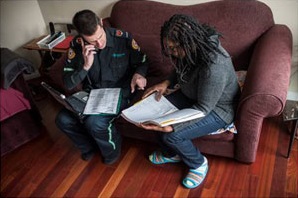“Working together to bring emergency care to palliative and end of life patients.”
What is the EMS Palliative and End of Life Care Assess, Treat, and Refer (PEOLC ATR) program?
 The PEOLC ATR program is designed to support people and their families who have chosen to remain at home for palliative and end of life care. It links clinicians with EMS resources to support patients in the community who are experiencing palliative emergencies in the hope that patients may be managed in place, rather than transported to an acute care setting. However, if patients choose and/or need to be transferred to an acute care setting, EMS will provide transport to the emergency department.
The PEOLC ATR program is designed to support people and their families who have chosen to remain at home for palliative and end of life care. It links clinicians with EMS resources to support patients in the community who are experiencing palliative emergencies in the hope that patients may be managed in place, rather than transported to an acute care setting. However, if patients choose and/or need to be transferred to an acute care setting, EMS will provide transport to the emergency department.
The program brings an interdisciplinary team directly to the patient. EMS and the clinician work together, with the patient and the patient’s family, to provide care aligned with the patient’s wishes and
Goals of Care.
The program may be initiated by EMS, who arrives in the home after a 911 call from the patient or family, or by a clinician, who has assessed the patient and determines additional support is needed on an urgent basis.
How do clinicians access the program?
A registered clinician who is on scene with the patient initiates the program.
EMS is activated by calling 911, however, clinicians will follow the PEOLC Assess, Treat, and Refer
dispatch script to activate the program, ensuring the most appropriate resource available is sent to the scene.
When should clinicians access the program?
Clinicians should access the program when they require EMS assistance during a palliative emergency (such as increased pain, shortness of breath, delirium, nausea or vomiting) and when the clinician is available to coordinate any follow up care that is required.
The program may be accessed for any palliative or end of life care patient in the community who is 18 years or older.
What will happen when EMS arrives?
EMS will come to the patient’s home without lights or sirens and work with the clinician to determine a potential course of treatment for the patient, collaboratively in the home or over the phone. EMS online medical consultation physicians and/or the patient’s family/palliative physician (if available) will also be consulted by phone regarding the patient’s treatment. EMS will help administer emergency medications, oxygen, and other supports as required.
If the patient is able to be managed in the community setting, EMS and the clinician will work together to support the patient’s Goals of Care and wishes. However, if transfer to an acute care setting is wanted or required, EMS will facilitate appropriate transport in consultation with the patient’s care team. The clinician will coordinate any follow-up care (e.g., prescription updates, arranging for medical supplies such as oxygen, and advising the patient’s responsible physician of the event).
Will this service cost me anything?
Ambulance response and transport is covered for patients on
Alberta Blue Cross Palliative Coverage.
Patients are encouraged to apply for this coverage as soon as possible so assess, treat and refer response services will be covered.
Find Out More
Other Resources for Health Professionals
Supplies
To order brochures to distribute to patients and families and clinician lanyard reference cards for staff, please see the following:
Contact Us
EMS.Palliative@albertahealthservices.ca
Information for:
